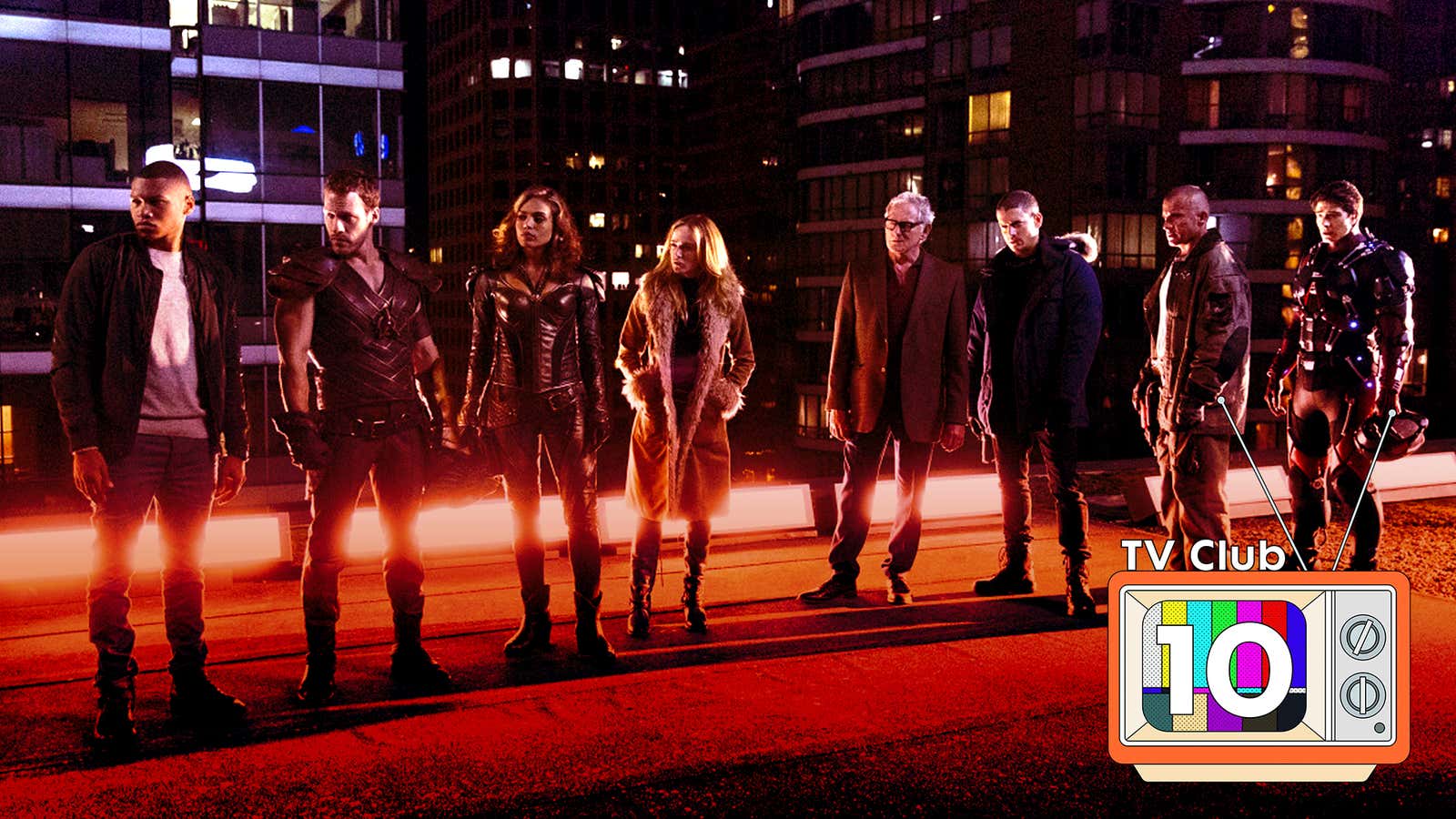
With TV Club 10, we point you toward the 10 episodes that best represent a TV series, classic or modern. They might not be the 10 best episodes, but they’re the 10 episodes that’ll help you understand what the show’s all about.
DC’s Legends Of Tomorrow is a weird show on every level—conceptually, plot-wise, and even in its overall journey. It was built as a spin-off from both The CW’s Arrow and The Flash, but it’s not really about fan-favorite characters who necessarily demanded to be given their own separate stories. Instead, the characters that really make sense on Legends are the ones who didn’t fit in on the shows that birthed them. Brandon Routh’s Ray Palmer was a quippy, gentler version of Iron Man on Arrow, but once he learned how to become a good superhero, there wasn’t anything for him to do. Similarly, Victor Garber’s Professor Martin Stein and Franz Drameh’s Jefferson Jackson—who each formed half of the superhero Firestorm—couldn’t find a niche on The Flash, since it already had smart people, and any issue big enough to require Firestorm’s bottomless set of powers should really be solved by the Flash anyway (his name is in the title).
So The CW punted those characters—along with Caity Lotz’s Sara Lance, Dominic Purcell’s Mick Rory/Heat Wave, Wentworth Miller’s Leonard Snart/Captain Cold, Ciara Renée’s Kendra Saunders/Hawkgirl and Falk Hentschel’s Carter Hall/Hawkman—off onto a time-traveling spaceship where they could fight an immortal despot (Casper Crump’s Vandal Savage) and have all sorts of superhero adventures without necessarily needing to infringe on the continuity of their parent shows. A fine idea, especially with actual veteran of time travel Captain Rip Hunter (Doctor Who’s Arthur Darvill) at the helm originally, but the cracks quickly started to show.
From the outset, Legends had a hard time wrangling its large cast of characters. The show failed to present them as people instead of pieces from other stories repurposed for a new narrative. This was especially the case with Carter and Kendra, referred to by Legends fans these days—with a sour grimace—as “the Hawkpeople.” Carter and Kendra, a pair of Egyptian lovers who were destined to die and be reborn over and over again throughout history, were living MacGuffins and the key to defeating Vandal Savage, which seems cool on paper. The problem is that they were just so damn boring. The writers never found anything interesting for them to do, falling back on Kendra’s repeated reminders that she used to be a barista so often that it seemed like a running joke (if the show had possessed the awareness at that point to even approach something like a running joke).
But Legends did what legends do: It lived on. It persevered and adapted and changed. In one of the most impressive turnarounds in genre TV history, the writers and actors shook off the things that didn’t work in season one—the villain, the Hawkpeople, the overly serious tone—and reshaped the show into something smarter and sillier. Rather than a show about screw-ups trying to do the right thing, it became a show about screw-ups owning the fact that they screw things up and trying to make the best of whatever goofy situations they found themselves in.
Also, most notably, the show began to reckon with its past, acknowledging that some aspects didn’t work without shying away from them or doubling-down and insisting that viewers were wrong to be critical (not to mention critics, but we’ll get to that later). More than The Flash or Arrow or whatever, Legends became a superhero show that was at least partially about superhero shows, winking at tropes or actively rejecting predictable superhero plots, like when an appearance from Supergirl, the Green Arrow, and the Flash that was teased in trailers turned out to just be those characters donating their costumes to the Legends so they could help promote the opening of a theme park—and it made sense in the context of the show.
So, in the madcap spirit of Legends Of Tomorrow’s transformation from a boring superhero team-up show to metafictional comedy show that just happens to be about superheroes, we’re going to break through the proverbial fourth wall and tweak the TV Club 10 format a little.
Sam Barsanti: Hello! I’m Sam Barsanti. DC’s Legends Of Tomorrow is my favorite TV show, and one that I’ve watched since the beginning. I followed its transition in real time, and I’ve been more than happy to recommend the series to people since the shift happened—with the all-important caveat that the beginning is rough and that the later stuff is better if you’ve experienced the bad beginning stuff. But this is a team-up show we’re talking about, so I’m going to do a team-up of my own by bringing in my colleague William Hughes. He did not watch Legends Of Tomorrow from the beginning (I’m not even sure if he’s seen the good seasons of Arrow!), but he gave it a shot on the recommendation from some smart person he works with and is now a fan with his own opinions on what makes the show work. So, William, what are your thoughts on Legends Of Tomorrow? Is the journey worth it? Have you seen the good seasons of Arrow?
William Hughes: First off: I do not grant the premise that there are “good seasons” of Arrow.
That being said: Hi, Sam! I would like to formally thank you for getting me into this series, even if I have to deduct, what, a season and a half from that thanks overall? (I cannot, with the Hawkpeople.) As someone who honestly doesn’t like the Arrowverse, and who aggressively skips the crossover episodes of this show when they cram their way into my Netflix feed, I feel like I speak for a particular cadre of people: those who want to watch a smart, silly superhero comedy and not have to worry about the Speed Force, or the mirror universe where everyone’s evil, or the Dominators—except when they’re being used to set up an episode-length E.T. joke. So let me address this to my people: Skip the first season of Legends Of Tomorrow. Watch the pilot if you want, but then jump ahead to season two. It still won’t be amazing or anything—the steady transformation from dour superhero drama into screwball comedy doesn’t really hit until the start of season three—but you won’t have an actively bad time watching Vandal Savage gloat at birds while Rip Hunter (a.k.a. “No fun today, Time Daddy’s feeling grumpy”) complains about his tragic backstory.
Because, yeah: The journey is legitimately, actually worth it. The funniest episodes of Legends Of Tomorrow are some of my favorite bits of TV comedy ever, and it’s wild to me that they’re buried behind an attention paywall formed out of Arthur Darvill’s Facial Hair Of Sorrow. For me, the evolution of Legends “getting good” is the development of the show learning to not take itself seriously, while (paradoxically) getting very serious about its silliness. You don’t see that kind of pivot very often in big-budget entertainment—and almost never this successfully—so I’m happy to highlight 10 episodes that track this show from bad superhero series (and it was bad, I know we don’t necessarily agree about this, but it really did suck) to amazing comedy with you.
SB: You might not like the crossovers, but we’re in the middle of one right now! What we’ve done here is divide up the entirety of DC’s Legends Of Tomorrow’s five seasons, with each of us taking turns picking an episode until we’ve compiled a list of the 10 that most effectively illustrate this bad-to-good-to-great journey. These aren’t necessarily the best episodes, though the ones we picked do include our personal picks for the best episodes, but—if you can only watch 10 episodes of Legends for some reason—these are the 10 you should watch. Also, for the creators of the show: Make a Beebo toy that I can buy ASAP. (Don’t know Beebo? Read on!)
Sam’s pick: “Pilot” (season one, episode one)
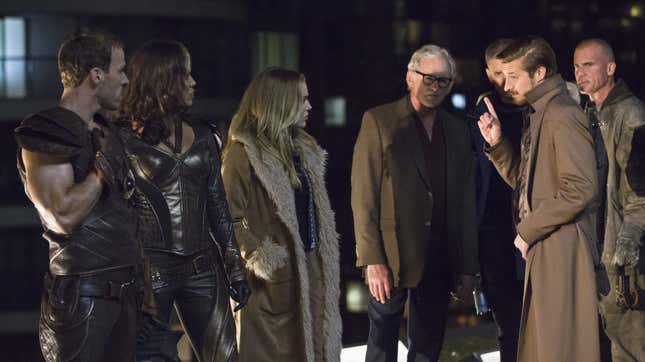
The first and most important thing to know about DC’s Legends Of Tomorrow is also something we all tend to learn as children: You can’t have dessert until you eat your vegetables. The show’s first season, unfortunately, is its vegetables. Oh sure, you could read a Wikipedia summary and get the basic setup needed to follow the plot later on, but appreciating where Legends eventually goes requires understanding where it’s been. Besides, you can swallow one piece of clumsily written and awkwardly acted broccoli if it means getting to enjoy a series covered in confidently playful and cleverly self-aware chocolate frosting. Metaphors aside, the pilot’s prolonged introductions to every member of the Legends—especially Captain Rip Hunter—saves you the trouble of having to come in with any foreknowledge of the larger Arrowverse. It’s an episode full of tossed-off exposition and seemingly arbitrary plot points, but at the risk of introducing another metaphor, it does eventually land on a crucial idea that would serve as the mold that shapes the rest of the series: The Legends weren’t assembled because they’re the best heroes for any particular job, but because they’re all losers who would otherwise make absolutely no mark on history. Even broccoli can be smart sometimes!
William’s pick: “Out Of Time” (season two, episode one)
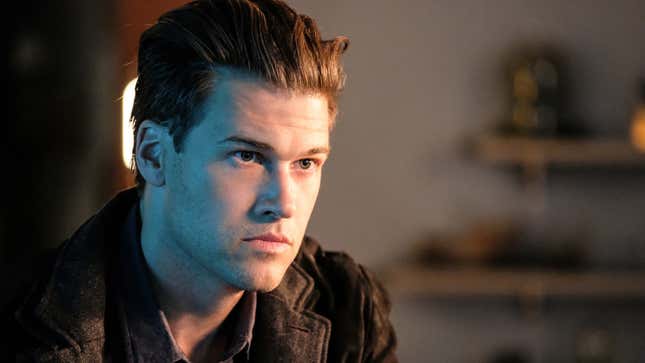
I can’t speak for you Sam, but to me, no character represents early (some might go so far as to say bad) Legends Of Tomorrow more thoroughly than Darvill’s Rip Hunter, a character whose role on the show usually boils down to yelling at everybody else for doing the silly things that might, say, make for an entertaining TV series. Happily, “Out Of Time” marks the point where Rip begins his (agonizingly slow) departure from the series, replaced by the far goofier Nick Zano as historical fanboy Nate Heywood. Meanwhile, you can see a general lightening up all over the place, from Sara (sliding into her spot as the show’s resident Captain Kirk stand-in) casually bedding the queen of France, to the montage of the team reassembling itself from the various points in history where they all get flung in the face of their latest Big Time Problem. The real turning point, though, has got to be Rip taking his leave; the characters are all sad about it, sure, but having the Legends lose their babysitter marks the point where the series can finally start pushing its comedy limits.
Sam’s pick: “Raiders Of The Lost Art” (season two, episode nine)
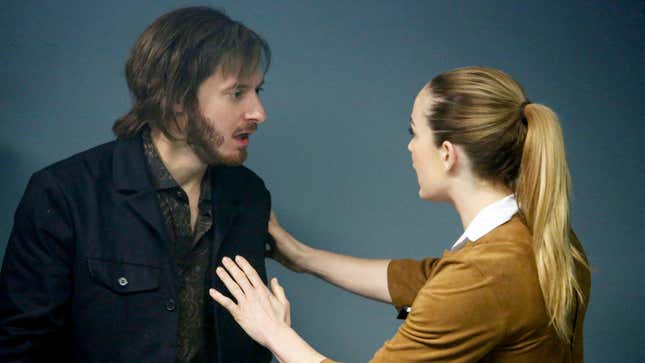
I’m sorry, what was that you were saying about Rip not being any fun? Granted, his brain has been wiped, and even as a hacky film director in the ’60s, he’s a pain in the ass, but… alright, Rip’s still not much fun here, though “Raiders Of The Lost Art” is extremely aware of how un-fun he generally is. The plot involves Rip erasing his memory to protect the location of the reality-altering Spear Of Destiny, but he inadvertently draws the Legends and the newly dubbed Legion Of Doom to his location by making a clumsily written and awkwardly acted movie called Legends about a time traveler fighting an immortal despot (sound familiar?). The meta-commentary is fun, but the real thrill comes when the superhero action scares Rip’s prop master—a young George Lucas!—away from ever making movies of his own, altering history and rewriting the backstories of both Nate Heywood and Ray Palmer (whose childhood obsessions with Indiana Jones and Star Wars made them into the heroes they are today). There’s a bunch of nods to the Lucas canon, including a somewhat clumsy excuse to toss the Legends into a trash compactor, and it’s all gleefully silly with only the vaguest pretense of being a serious superhero show.
William’s pick: “Aruba-Con” (season three, episode one)
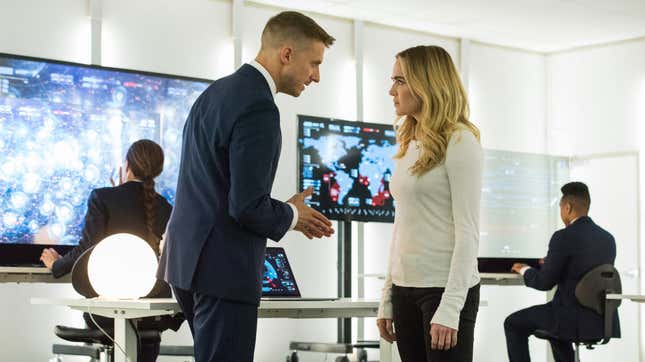
I’ll be honest: This is the moment that Legends went from a show I was watching because someone *cough* Sam *cough* told me it eventually got good, to when I actually started saying “Hey, this is pretty good!” myself. The key, as alluded to earlier in the conversation, is the show’s transformation from a sci-fi superhero series that happens to have some jokes in it, into a straight-up comedy series about a bunch of super-powered goof-ups “screwing things up for the better.” It’s not a coincidence that this shift comes part and parcel with the introduction of The Time Bureau, a crew of supposedly uber-efficient government agents designed to cast the Legends themselves as a team of time-trashing wrecking balls. It doesn’t hurt that “Aruba-Con” introduces both Adam Tsekhman and Jes Macallan into the show’s cast, upping its comedic firepower considerably; I’m not sure I’d go so far as to say “Just start with this one”—context helps—but like I said, season three is when the Legends l love actually start showing up on the screen.
Sam’s pick: “Beebo The God Of War” (season three, episode nine)
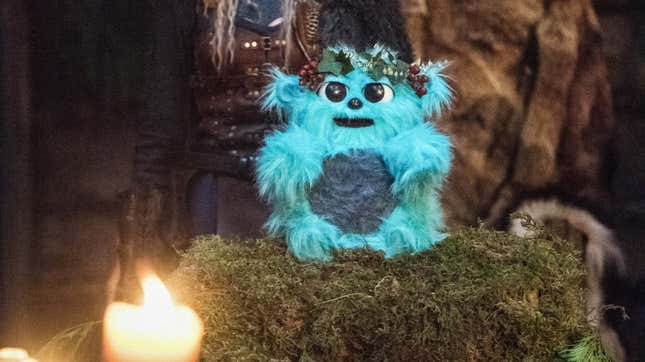
Thanks to some tweaks to the premise and those additions to the cast, we are now at the point where Legends has all the time circuits firing at full speed, and I believe “Beebo The God Of War” is the single best episode of Legends, of the whole Arrowverse, and maybe of TV in general (and lest we forget, I was right to recommend Legends Of Tomorrow, so I might also be right about this). The premise is simple: A Tickle Me Elmo-style must-have toy is sent back to 1000 AD, where Leif Erikson and his Viking crew decide that the talking stuffed animal must be a god and that his adorable catchphrases like “I luh-luh-love you!” must mean that he’s commanding them to conquer the world. It’s a goofy take on the time-travel trope about sending advanced technology into the past, but with advanced technology that is very, very silly. Also good: It ends with Matt Ryan’s John Constantine (from that one-season NBC show and some guest appearances on Arrow) joining the team. The episode is pure time-travel hijinks, and I absolutely adore it.
William’s pick: “Here I Go Again” (season three, episode eleven)
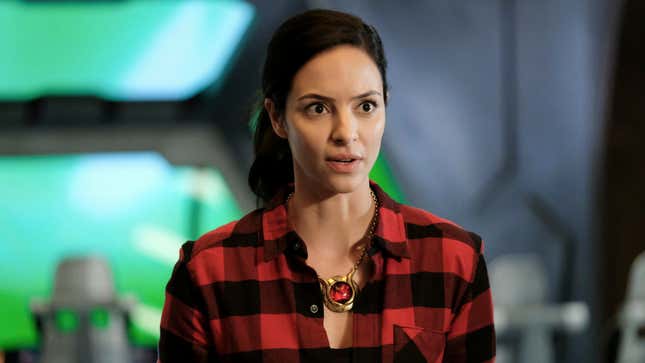
Sam, it’s so weird that you would assert “Beebo”’s supremacy, given that the actual best episode of Legends comes just two episodes later. (It’s this one.) For a show with an absolutely bewildering number of cast shake-ups over the years, no Legends episode has ever done a character introduction better than “Here I Go Again,” which nigh-magically transforms Tala Ashe’s wind-powered Zari from an awkward outsider into a core part of the Waverider crew. The trick? A classic “Hedgehog Day” scenario, looping Zari through the same set of ship-destroying events over and over—and teaching her to love being a Legend in the process. Besides being a showcase for Ashe’s considerable comic chops, “Here I Go” is Legends at its most aggressive “Let’s just have fun with this,” almost always my favorite look for the show. It’s not for nothing that multiple throwaway gags that got their origin here—the ABBA/“Waterloo”/Waterloo joke, but also the running gag of Mick’s secret life as sci-fi romance novelist Rebecca Silver—wound up coming back with increasing importance. Season three of Legends Of Tomorrow: It’s not screwing around.
Sam’s pick: “Guest Starring John Noble” (season three, episode 17)
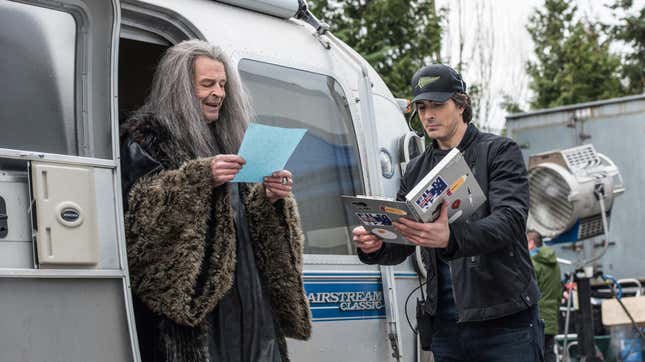
Now here’s an interesting problem: What if we’re both wrong about the best episode of Legends? Because a very good case could be made for “Guest Starring John Noble,” which features Gorilla Grodd trying to kill young Barack Obama as part of an evil demon called Mallus’ plan to destabilize all of history. There’s a good gag with Grodd referring to Obama as “Barry,” which is just to set up a “run, Barry, run!” joke (which is a line that The Flash viewers will recognize from… most episodes), but the greatest gag of all is the one teased by the title. After overhearing Mick watching the Lord Of The Rings movies, the Legends realize that Mallus sounds an awful lot like actor John Noble (because John Noble actually plays Mallus), so they go to 1999 and visit the set of the Lord Of The Rings movies so they can get John Noble (now playing himself) to record some fake Mallus quotes that undermine his nefarious scheme. John Noble (the character) even complains about the new lines because he thinks they’re disrespectful to J.R.R. Tolkien’s original text, which is itself a meta-joke about Peter Jackson’s movies and a wink to the fact that the Legends met young Tolkien in season two’s “Fellowship Of The Spear.” This is a show operating at absolute maximum confidence, and it has nothing but respect for its actors, writers, and—especially—viewers.
William’s pick: “The Good, The Bad, And The Cuddly” (season three, episode 18)
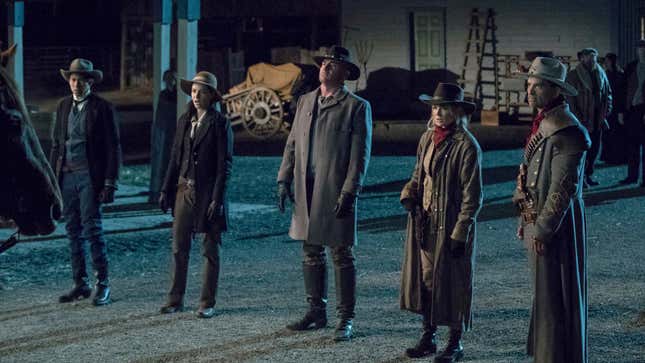
If you’ve ever seen a meme of Legends Of Tomorrow, it’s probably from the climax of this, the third-season finale—and if we’re going very hard on the show’s third season here, it’s only because it’s the mountain that Legends spent two long, Rip Hunter-heavy years climbing toward. The image of a giant-sized, bright blue Beebo fatally power-bombing a leather-winged demon into a heart-shaped cloud of dust will always be the Legends moment, the apex of audacity that all subsequent finales are forced to try to live up to. And it’s not even the funniest moment of the episode! (That comes from the Legends’ first effort to use their magical totems to make a perfect warrior, instead crapping out a horrifying Cronenberg monster that has to be swiftly put out of its misery.) Like “John Noble” before it, “The Good, The Bad, And The Cuddly” is a perfect expression of confidence by all involved, firm in their belief that the blend of absolute silliness, real feeling, and somehow-not-all-that-cheap-looking superhero action they’d been cultivating could produce something even greater than the sum of its parts. All that, and they finally killed off Rip! Bye-bye, Time Daddy: Your babies are ready to fly.
Sam’s pick: “Wet Hot American Bummer” (season four, episode four)

With the heavy lifting accomplished in William’s pick, Legends Of Tomorrow can now slide into the position of being a show that may not appeal to everyone but at least appeals to the specific people who will “get it.” More importantly, though, this is the episode where they talk about The A.V. Club. How could we not pick this? It opens with Sara and Ava laying in bed and watching a crappy horror movie (Swamp Thaaaang), but when they’re confused by its very existence, they do what everyone should do and check to see what The A.V. Club has to say about it. In the Arrowverse, we apparently gave the movie a “D+” and said that “the production design is as lazy as the action staging,” which Sarah shrugs off as “harsh.” We disagree, though, because that’s almost an exact quote from Oliver Sava’s D+ review of the season one Legends episode “Last Refuge.” On a weaker show, calling out the critics like that would be painfully desperate, as if to say “you think we’re bad but we’re actually good and you’re dumb,” but this little wink lets the viewers (and specifically us) feel like we’re part of a larger community. It’s not “you were wrong,” it’s “look how far we’ve come together.” Legends might as well be saying “I luh-luh-love you” to everybody watching.
William’s pick: “The One Where We’re Trapped On TV” (season five, episode thirteen)
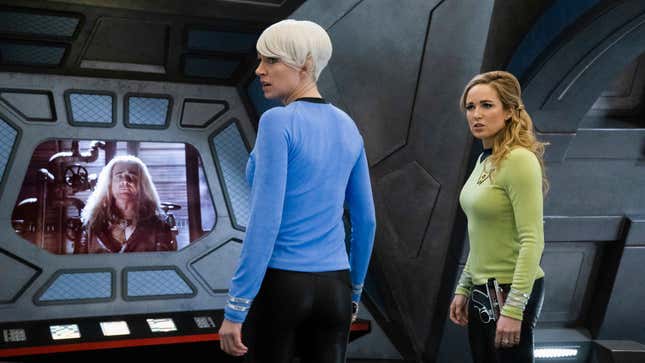
Sam, you and I had a bit of back-and-forth about whether this episode, or season-five finale “Swan Thong”—i.e., the one where Sisqo shows up to serenade the Legends while they beat up Stalin and Marie Antoinette—was a better representation of where Legends is at as we roll into its upcoming sixth season. But “The One Where We’re Trapped On TV” (and yes, the Friends reference is extremely deliberate) wins for me because it does everything this show does well so… well, well. The aggressive desire to play with format is a given, since this is, as the title alludes, the episode where the Legends get stuck in their own private WandaVisions, trapped in approximations of Friends, Downton Abbey, Star Trek, and Mister Rogers’ Neighborhood. (The whys don’t really matter; if you want plot, there are other Arrowverse shows for that.) But as much fun as watching Nick Zano and Shayan Sobhian play Duelin’ Joey Tribbiani’s is, “TOWWTOT” also never loses track of the little nugget of heart that keeps the show feeling just real enough to weather all this absurdity. Olivia Swann and especially Matt Ryan (whose Constantine is probably the most successful of the series’ periodic imports of outside DC show talent) ground the goofiness with genuine feeling, and the final, only semi-nonsensical solution to the whole predicament is winningly sweet. Is it a gimmick episode? Sure. But it’s a gimmick with heart and soul—and that’s the intersection where this show demonstrates what Legends really are.
